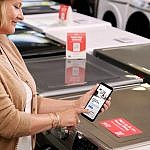Even before the coronavirus pandemic impacted e-commerce storefronts (mostly positively) and brick-and-mortar establishments (not so much), retailers were focused on various strategies to adapt, survive and thrive in the face of fast-changing consumer preferences. However, the COVID-19 quarantines and shut-downs led to an essential realization: While not all consumers necessarily embraced online shopping, most really liked the convenience and speed attached to it.
As a result, flexible retailers these days are placing more focus on last-mile delivery as a customer service tool, using technology and out-of-the-box thinking to improve product receipt and store-to-customer experiences.
The Omnichannel Emphasis
In this day and age, it’s a given that physical retailers need some kind of omnichannel model. An effective omnichannel strategy ensures a seamless customer experience, whether said customer buys goods via smartphone, or travels to a bricks-and-mortar destination.
How such a strategy works can differ, based on the retailer and customer base. For example, retailer Target Corp. is investing approximately $4 billion annually over the next several years on store remodels, fulfillment enhancements, and supply chain improvements, all with the goal of making the shopping experience easier for customers through various channels.
One interesting aspect is the inclusion of new “sortation centers,” facilities with the sole purpose of collecting online orders from stores multiple times a day, and sorting those orders into more efficient delivery routes.
Speaking of which, a delivery solutions provider, like Dolly, with our ability to build out local delivery solutions that flex and scale with your business, can help boost omnichannel efforts, providing streamlined last-mile logistics and assistance in meeting customer requirements and timelines.
“We Wanted it Yesterday”
Once upon a time, customers would willingly wait days, or even weeks, for parcels to arrive. Even online shoppers were okay with a two- or three-day turnaround on the receipt of most goods.
But not anymore. SOTI’s “From Bricks to Clicks: State of Mobility in Retail 2021 Report” noted that 45% of consumers surveyed said if delivery or pick-up of an item takes more than two days, those consumers will shop elsewhere. The report also said that 57% of those surveyed were frustrated by the shipping, delivery, and return aspects of online ordering.
Again, customers want convenience, and they want things at once. This is one reason why global retail giant Amazon continues pouring billions into its transport efforts, in an effort to beef up its logistics infrastructure and distribution efforts.
This is Amazon, though. Most retailers don’t necessarily have the financial resources to put an extensive logistics network with streamlined last-mile activities into place. One way to get products quickly to consumers, based on their timelines, is to partner with a delivery solutions provider, especially one like Dolly that is able to meet your customers’ expectations of on-demand delivery, which can help deliver goods quickly to customers homes.
Another method is to enhance curbside pickup or contactless collection activities.
Curbside and Contactless Convenience
Pre-paying for a product online, then traveling to the store to pick up that item, isn’t new. But this shopping method expanded during the pandemic, with consumers collecting their goods via curbside pickup and contactless collection.
With curbside pickup, the consumer drives to the store, and waits in a pre-designated spot for a product to be brought to him or her. Contactless collection operates on a similar principle, except the customer picks up that product at a pre-designated spot within, or just outside, the store.
The Container Store took curbside pick up a few steps further during the pandemic. While the storage and organizational product retailer scheduled in-store appointments, allowing only a handful of customers at a time into the stores, it also improved its ability to bring products to customers who had pre-ordered online, and came by for pick-up.
The challenge, however, was when curbside pickup customers wanted to purchase additional products without having to make appointments and wait. To handle this, The Container Store encouraged online ordering, with goods shipped directly from stores to customers’ homes. The uptick in delivery demand led to an adjustment to The Container Store’s partnership with Dolly, a local big and bulky delivery solutions provider. Along with delivering large items, like custom closets, for The Container Store, Dolly also began offering routed small item delivery.
Dolly Helpers arranged delivery times that suited customers’ schedules, then picked up items from the store, and delivered them. The process tapped into both the speed and convenience demanded by shoppers.
Retail Space or Distribution Center?
In early 2021, Walmart announced it would shift part of its brick-and-mortar efforts into distribution and fulfillment functions. These local fulfillment centers, or LFCs, are fully automated, mini-warehouses built within, or adjacent to, a Walmart store. The facilities store items that are in high demand, meaning less time to customer fulfillment. The customer places an order online, the LFC system fulfills the order, and has it ready for either pickup or delivery in minutes. Walmart saves on shipping costs, and customers receive their products quickly.
This isn’t so far off the quick-service restaurant pick-up and delivery model. Pizza Hut and Dominos deliver their food to customers within a certain radius for a reason. It ensures that customers receive their food hot, and in a timely fashion.
Not all retailers have the resources of a Walmart, nor do they have the ability to construct on-site mini-warehouses. And, most retailers aren’t in the business of delivering pizzas. But most retailers should consider how their brick-and-mortar locations can help meet consumer demand for speed and delivery convenience.
Retailers partnering with a local delivery solutions provider offer convenience while reducing shipping costs. This particular strategy also helps move in-store inventory to consumers more quickly and efficiently. For instance, Dolly’s wide range of services means we can pick up items from a store, even outside of normal working hours, pick up from a distribution center, or anywhere that you house your goods, and get them delivered—even in as little as 90 minutes.
Shifting to Meet the Challenges
The coronavirus pandemic hasn’t necessarily forced retailers to take on different methods of product movement and customer service. This adaptation has been going on for some time. What COVID-19 has done is unveiled and underlined consumer demands for fast and convenient product receipt, whether that receipt involves same-day delivery or contactless collection. This demand, in turn, has focused on last-mile delivery as a key to customer service.
As such, to build and maintain competitiveness in the face of changing consumer demands, successful retailers should work on improving the store-to-customer experience. Last-mile delivery strategies can help improve customer service by meeting consumer needs.
Dolly helps you move on your schedule and at an affordable price. Book now and see the difference: https://dolly.com.






